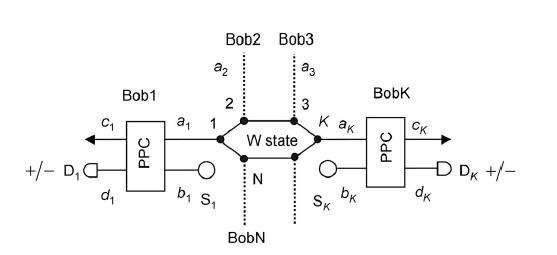An efficient approach to concentrate arbitrary N-particle W state

Entanglement is an important quantum resource in both quantum communication and computation. The applications of entanglement information processing such as quantum teleportation, quantum key distribution (QKD), quantum dense coding, quantum secret sharing (QSS), and quantum secure direct communication (QSDC) all resort the entanglement to set up the quantum channel between long distant locations. The multi-particle W entangled state cannot be converted to the Greenberger-Horne-Zeilinger (GHZ) state directly with local operation and classical communication (LOCC). The multi-particle W entangled state also plays an important role in quantum information processing, such as teleportation, superdense coding, and so on.
During the practical application, one of the main obstacles comes from the channel noise. It will make the maximally entangled state become a less-entangled state. The degraded entangled state will decrease the efficiency of the quantum communication, and it will also make the quantum communication insecure. Entanglement concentration focuses on the pure less-entangled system, which can be used to recover a pure less-entangled state into a maximally entangled state with LOCC.
Though many entanglement concentration protocols (ECPs) were proposed, they either focus on the two-particle Bell-state, or some three-particle W entangled states, especially the W state with special structure. No protocol can concentrate an arbitrary N-particle W state.
This paper described an efficient approach to distill the arbitrary N-particle less-entangled W state into maximally entangled W state in an optical system. The main principle of this approach is to exploit the parity-check gate. It comprises two protocols. The first protocol uses the partially parity-check (PPC) gate. It is essentially a polarization beam splitter (PBS). The second protocol uses the cross-Kerr nonlinearity to implement the complete parity-check (CPC) gate. Both protocols require the single photon as auxiliary. For an N-photon less-entangled W state concentration, it requires N-1 auxiliary single photons. If exploiting the CPC gate to perform the concentration, each step can be repeated to obtain a higher success probability. Our research also reveals that the total success probability is related to the initial coefficients of the less-entangled W state, especially the minimum coefficient. In other words, the success probability is essentially related to the entanglement of the less-entangled W state, which is decided by the minimum coefficient.
These protocols provided a universal approach to concentrate the arbitrary N-photon less-entangled W state. The first protocol only requires the PBSs, which is feasible in the current experiment. The second protocol with the cross-Kerr nonlinearity can obtain higher success probability. Both protocols may be useful in future quantum information processing.
More information: Sheng Y B, Pan J, Guo R, et al. Efficient N-particle W state concentration with different parity check gates. Sci China-Phys Mech Astron, 2015, 58(6): 060301. DOI: 10.1007/s11433-015-5672-9
Provided by Science China Press




















